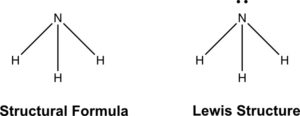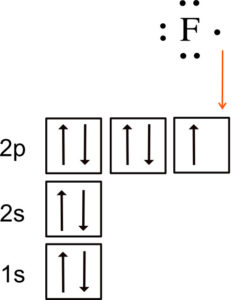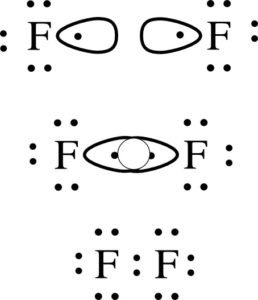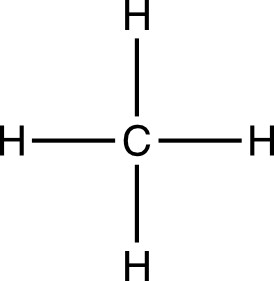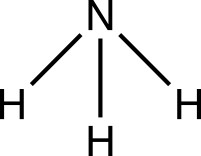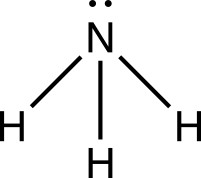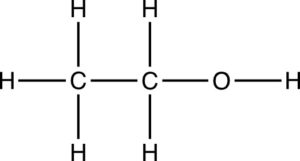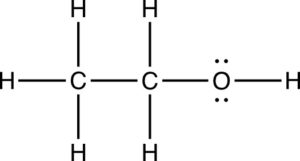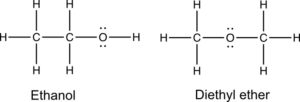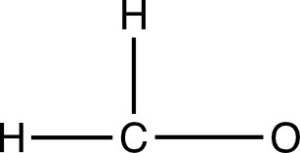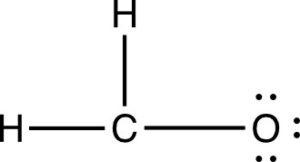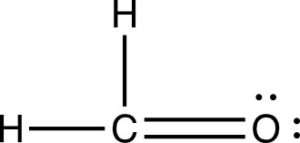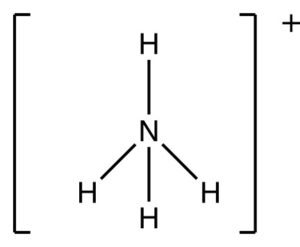Besides providing a shorthand notation of an atom’s valence electron count and its configuration, Lewis dot symbols also lay the foundation for connecting the atoms in a molecule. This results in the Lewis structure. A Lewis structure is a structural formula that shows the covalent bonds and electron pairs. Recall that a Lewis dot symbol refers to an elemental symbol with dots used to represent the valence electrons. In the figure below, both a structural formula and a Lewis structure are shown for ammonia, NH3. Note, in the Lewis structure there is a pair of electrons on nitrogen.
In a previous study guide we discussed how atoms obtain noble gas configurations by either accepting or losing electrons. We know that octets can also be completed by the sharing of electrons between atoms. Consider the fluorine atom’s valence shell. We have seen that the fluorine atom can complete the octet of its valence shell by accepting an additional electron and forming the negatively charged fluoride ion. The second way a fluorine atom can obtain a noble gas configuration is by sharing electrons. The unshared electron on the right hand side of the Lewis dot structure, in the figure below, corresponds to the unshared electron in the orbital box diagram directly below it.
The process by which electrons are shared between two atoms is possible through the overlapping of the orbitals containing the unshared electrons (see figure below).
Notice that in the formation of diatomic molecular fluorine, F2, each of the fluorine atoms has an octet of electrons in its valence shell. Octets and doublets (2 electrons) can also be completed by two dissimilar atoms sharing valence electrons. For example, consider the molecule hydrogen chloride, HCl. The Lewis dot structures show hydrogen with one valence electron and chlorine with seven valence electrons. By overlapping the orbitals of the single unshared electron in the hydrogen’s 1s orbital with the single unshared electron in a 3p orbital of the chlorine, the hydrogen and the chlorine can each share an extra electron. This will complete a doublet for the hydrogen and complete the octet for the chlorine atom.
The Lewis Structure is drawn as
with the two shared electrons, a single covalent bond, being represented by a straight line, whereas the unshared electrons on the chlorine atom, called lone pairs or nonbonding electrons, remain in dot notation. A single covalent bond is a bond formed by the sharing of two electrons.
From the periodic table we can determine the number of bonds that each element will form.
Group 4A, there are 4 valence electrons and elements like carbon can form 4 covalent bonds as in CH4.
Group 5A, there are 5 valence electrons, and elements like nitrogen can form 3 covalent bonds as in NH3.
Group 6A, there are 6 valence electrons, and elements like oxygen can form 2 covalent bonds as in H2O.
Group 7A, there are 7 valence electrons, and elements like Chlorine can form 1 covalent bond as in HCl.
Group 8A, there are 8 valence electrons, and these elements have a full octet and rarely form bonds with other substances.
An approach to drawing Lewis structures for molecules and ions requires a few simple rules. Before proceeding, we need to understand that within a molecule or polyatomic ion all of the electrons shared between atoms (covalent bonds) and those that are not shared (lone pairs) are from the total number of valence electrons. For example, the molecule methane, CH4, has 4 hydrogens covalently bonded to carbon. First count the number of valence electrons. There are 4 valence electrons for carbon and 1 valence electron for each of the 4 hydrogen atoms. This is a total of 8 valence electrons. We first draw a skeletal structure with single covalent bonds.
Count the electrons in the bonds. There are a total of 8 electrons. Finally, check that carbon has an octet. It does and we have a valid Lewis structure for CH4.
Next, we can look at NH3. There are a total of 8 valence electrons. Draw the skeletal structure with single covalent bonds.
We have used 6 electrons for the single bonds. There are 2 electrons left, and they are placed on the central nitrogen atom. The nitrogen atom has an octet of electrons and the hydrogens each have a doublet. This is a valid Lewis structure.
The Lewis structure for C2H6O has two carbon atoms, 6 hydrogen atoms and 1 oxygen atom. The total number of valence electrons is 20 electrons. We first draw the skeletal structure.
We have used 16 electrons for the bonds and there are 4 electrons left. The 2 pairs of electrons are placed on oxygen to give it an octet. The carbons and oxygen have an octet and the hydrogens have doublets.
We could have drawn another valid Lewis structure for C2H6O as shown in the figure below. Both have octets around the carbons and oxygen and doublets on the hydrogens. Both have the same molecular formula, but they are different compounds. One is ethanol and the other is dimethyl ether. These compounds are called isomers. The only difference between the two structures is the way the atoms are connected. Compounds with the same molecular formula are called isomers. These two isomers are called constitutional isomers because their atoms are connected differently. Later, you will learn about other types of isomers, but for now we are only concerned about constitutional isomers.
Next, we can draw the Lewis structure for CH2O. There are a total of 12 valence electrons. Draw the skeletal structure.
Place the remaining electrons on oxygen
Note, the hydrogens have doublets, the oxygen has an octet, but the carbon does not have an octet. Move one of the lone pairs from oxygen to form a double bond with carbon.
Carbon now has on octet, and the above is a valid Lewis structure.
Let’s draw a Lewis structure for HCN. There are 10 valence electrons. The skeletal structure is
Next, we place the remaining electrons on the nitrogen atom.
Nitrogen has an octet but carbon is only surrounded by 4 electrons. Move 2 electron pairs to the carbon to form a triple bond between carbon and nitrogen. We now have a valid Lewis structure with octets around both nitrogen and carbon.
Draw the Lewis structure of NH4+. Count the valence electrons — there are 9 valence electrons. We must subtract one electron for the +1 charge. There are a total of 8 valence electrons. When drawing a structure for an ion, brackets are used with the charge in the upper right hand corner of the closing bracket. The Lewis structure for NH4+ is
Note the nitrogen has an octet of electrons. This is a valid Lewis structure.
Worksheet: Lewis Structures Part 1: The Basics
Worksheet: Lewis Structures Part 2
Worksheet: Lewis Structures Part 3: Formal Charge
Worksheet: Isomers: Introduction
Watch the following video on how to draw Lewis Structures
Exercises
Exercise 1. Draw a Lewis structure for water, H2O.
Exercise 2. Draw a Lewis structure for acetic acid, CH3COOH.
Exercise 3. Draw a Lewis structure for PCl3
Exercise 4. Draw a Lewis structure for OF2
Exercise 5. Draw a Lewis structure for H3O+
Check Solutions/Answers to Exercises
Back to Covalent Bonds and Lewis Dot Structures
Back to General Chemistry 1 Study Guides
Back to Home Page

